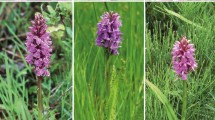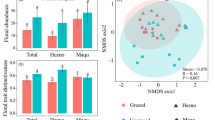Abstract
A review of the literature, compiled over the past 40 years suggests new directions for theories discussing the evolution of reproductive isolation and entomophily in angiosperms. Data on breeding systems suggests that the protoangiosperms may have developed gametophytic self-incompatibility. Protogyny is probably ancestral to protandry and herkogamy. Although the proto-flowers were bisexual wide variation in the number of sexual organs within proto-flowers probably led to labile sexuality and early trends towards dicliny. Beetle-pollination in extant relicts appears too specialized to represent an ancestral condition. Rather, the proto-flowers may have been generalist entomophiles incorporating some beetles,Plecoptera, thrips, micropterigid moths and proto-dipterans into their fluctuating spectra of opportunistic pollinators. Bee-pollination is probably polyphyletic in origin evolving repeatedly from angiosperms showing these generalist syndromes. There is still no correlation between primitive bees (especiallyColletidae) and the relictual angiosperms. Pollen that is usually retained within the anthers following dehiscence and the presence of staminal filaments and styles characterizes most of the flowers of those relictual angiosperms pollinated by specialized, modernApoidea.
Similar content being viewed by others
References
Armstrong, J. A., 1979: Biotic pollination mechanisms in the Australiar flora—a review. — New Zealand J. Bot.17, 467–508.
Bawa, K. S., 1974: Breeding systems of tree species of a lowland tropical community. — Evolution28, 85–92.
—, 1981: Evolution of sexual systems in flowering plants. — Ann. Missouri Bot. Gard.68, 254–274.
—, 1985a: Reproductive biology of tropical lowland forest trees. I. Sexual systems and incompatibility mechanisms. — Amer. J. Bot.72, 331–345.
—, 1985b: Reproductive biology of tropical lowland rain forest trees. II. Pollination systems. — Amer. J. Bot.72, 346–356.
Beach, J. H., 1982: Beetle pollination ofCyclanthus biparitus (Cyclanthaceae). — Amer. J. Bot.69, 1074–1081.
Bernhardt, P., 1982: Insect pollination of AustralianAcacia. — InWilliams, E. G., Knox, R. B., Gilbert, J. H., Bernhardt, P., (Eds.): Pollination '82. — Parkville, Vic.: Melbourne Univ. Press.
—, 1984: The pollination biology ofHibbertia stricta (Dilleniaceae). — Pl. Syst. Evol.147, 267–277.
—, 1986: Bee-pollination inHibbertia fasciculata (Dilleniaceae). — Pl. Syst. Evol.152, 231–241.
Bernhardt, P., Kenrick, J., Knox, R. B., 1984: Pollination biology and the breeding system ofAcacia retinodes (Leguminoseae: Mimosoideae). — Ann. Missouri Bot. Gard.71, 17–29.
—, 1984: Bee foraging on three sympatric species of AustralianAcacia. — Intl. J. Ent.26, 322–330.
—, 1986: Floral mimesis inThelymitra nuda (Orchidaceae). — Pl. Syst. Evol.151, 187–202.
Buchmann, S. L., 1983: Buzz pollination in Angiosperms. — InJones, C. E., Little, R. J., (Eds.): Handbook of Experimental Pollination Biology. — New York: Van Nostrand-Reinhold Inc.
Corner, E. J. H., 1952: Wayside Trees of Malaya. 2. ed. — Singapore: Govtg. Print. Off.
Crepet, W. L., 1983: The role of insect pollination in the evolution of the angiosperms. — InReal, L. (Ed.): Pollination Biology. — San Francisco: Academic Press.
Cronquist, A., 1981: An Integrated System of Classification of Flowering Plants. — Columbia Univ. Press.
Crowson, R. A., 1981: The Biology of theColeoptera. — Academic Press.
Diels, L., 1916: Käferblumen bei denRanales und ihre Bedeutung für die Phylogenese der Angiospermen. — Ber. Deutsch. Bot. Ges.34, 758–774.
Endress, P. K., 1984: The flowering process in theEupomatiaceae (Magnoliales). — Bot. Jahrb. Syst.104, 297–319.
—, 1981: Diversity and evolutionary trends in the structure ofTambourissa (Monimiaceae). — Pl. Syst. Evol.153, 53–81.
Faegri, K., van der Pijl, L., 1971: The Principles of Pollination Biology. — Oxford: MacGraw-Hill. 2nd ed.
Frankie, G. W., Haber, W. A., Opler, P. A., Bawa, K. S., 1983: Characteristics and Organization of the large bee pollination system in the Costa Rican Dry forest. — InJones, C. E., Little, R. J., (Eds.): Handbook of Experimental Pollination Biology. — New York: Van Nostrand-Reinhold Inc.
Free, J. D., 1970: Insect Pollination of Crops. — London, New York: Academic Press.
Gazit, S., Galon, I., Podoler, H., 1982: The role of nitidulid beetles in natural pollination ofAnnona in Israel. — J. Amer. Soc. Hort. Sci.107, 849–852.
Gentry, A. H., 1974: Flowering phenology and diversity in tropicalBignoniaceae. — Biotropica6, 64–68.
Gibbs, P. R., Semir, J., Cruz, N. D., 1977: Floral biology ofTalauma ovata St. Hil. (Magnoliaceae). — Cien. Cult.29, 1436–1441.
Godley, E. J., Smith, D. H., 1976: Self-sterility inPseudowintera colorata. — Triennial report (Botany Division, DSIR)75, 61.
Gottsberger, G., 1970: Beiträge zur Biologie von Annonaceen-Blüten. — Österr. Bot. Z.118, 237–279.
—, 1977: Some aspects of beetle pollination in the evolution of flowering plants. — Pl. Syst. Evol. Suppl.1, 211–226.
—, 1980: Reproductive biology in the primitive relic angiospermDrimys brasiliensis (Winteraceae). — Pl. Syst. Evol.135, 11–39.
Grant, V., 1950: The pollination ofCalycanthus occidentalis. — Amer. J. Bot.37, 294–297.
—, 1975: Genetics of Flowering Plants. — New York: Columbia Univ. Press.
Haber, W. A., Bawa, K. S., 1984: Evolution inSaurauia (Dilleniaceae). — Ann. Missouri Bot. Gard.71, 289–293.
Heiser, C. B., Jr., 1962: Some observations on pollination and compatibility inMagnolia. — Proc. Indiana Acad. Sci.72, 259–266.
Heslop-Harrison, Y., Shivanna, K. R., 1977: The receptive surface of the angiosperm stigma. — Ann. Bot.41, 1233–1258.
Hesse, M., 1979: Zur Frage der Anheftung des Pollens an blütenbesuchenden Insekten mittels Pollenkitt und Viscinfäden. — Pl. Syst. Evol.133, 102–135.
Keighery, G., 1975: Pollination ofHibbertia hypericioides (Dilleniaceae) and its evolutionary significance. — J. Nat. Hist.9, 681–684.
Kubitzki, K., Kurz, H., 1984: Synchronized dichogamy and dioecy in neotropicalLauraceae. — Pl. Syst. Evol.147, 253–266.
Lorence, D. H., 1980: A Systematic and Eco-Evolutionary Study of theMonimiaceae in the Malagasy Region. — Ph.D. Thesis, St. Louis: Washington U.
McDaniel, J. C., 1963: Securing seed production inMagnolia acuminata andM. cordata. — Proc. Int. Plant Prop. Soc. East. Reg. 13th Annual meeting, 120–132.
Michener, C. D., 1979: Biogeography of the bees. — Ann. Missouri Bot. Gard.66, 277–347.
Meeuse, B. J. D., Schneider, E. L., 1979:Nymphaea revisited: A preliminary communication. — Israel J. Bot.28, 65–79.
Norton, S. A., 1980: Reproductive Ecology ofPseudowintera (Winteraceae). — M.S. Thesis, Wellington, New Zealand, Victoria University.
Nowicke, J. W., Meselson, M., 1984: Yellow rain—A palynological analysis. — Nature309, 205–206.
Parks, C. R., Miller, N. G., Wendel, J. F., McDougal, K. M., 1983: Genetic divergence within the genusLiriodendron (Magnoliaceae). — Ann. Missouri Bot. Gard.70, 658–667.
Pellmyr, O., Thien, L. B., 1986: Insect reproduction and floral fragrances; Keys to the evolution of the angiosperms? — Taxon (in press).
Prakash, N., Alexander, J. H., 1984: Self-incompatibility inAustrobaileya scandens. — InWilliam, E. G., Knox, R. B., (Eds.): Pollination '84. — School of Botany, University of Melbourne.
Prance, G. G., Anderson, A. B., 1976: Studies the floral biology of neotropicalNymphaeaceae 3. — Acta Amazonica6, 163–170.
—, 1975: A study of the floral biology ofVictoria amazonica (Poepp.)Sowerby (Nymphaeaceae).3. — Acta Amazonica5, 109–139.
Proctor, M., Yeo, P., 1972: The Pollination of Flowers. — New York: Taplinger Publ. Co.
Schneider, E. L., 1979: Pollination biology of theNymphaeaceae. — InCaron, D. M., (Ed.): Proc. IV Int. Symp. Poll. Maryland Ag. — Exp. Sta. Spec. Misc. Publ.1, 419–430.
—, 1983: Gross morphology and floral biology ofOndinea purpurea Den Hartog. — Austral. J. Bot.31, 371–382.
—, 1982: Notes on the floral biology ofNymphaea elegans (Nymphaeaceae) in Texas. — Aquatic Bot.12, 197–200.
—, 1980: Morphological studies of theNymphaeaceae. XI. The floral biology ofNelumbo pentapetala. — Amer. J. Bot.67, 182–193.
—, 1981: The floral biology ofNymphaea odorata (Nymphaeaceae). — The Southwestern Nat.26, 159–165.
—, 1982: Morphological studies of theNymphaeaceae. XII. The floral biology ofCabomba caroliniana. — Amer. J. Bot.69, 1410–1419.
—, 1977: Morphological studies of theNymphaeaceae. VII. The floral biology ofNuphar lutea subsp.macrophylla. — Britt.29, 88–99.
Semple, K. S., 1974: Pollination inPiperaceae. — Ann. Missouri Bot. Gard.61, 868–871.
Silberbauer-Gottsberger, I., 1972: Blüten- und Fruchtbiologie vonButia leiospatha (Arecaceae). — Österr. Bot. Z.121, 171–185.
Snigiruskaya, N. S., 1964: Contributions to the morphology and systematics of the genusNelumbo. — Tr. Bot. Inst. Komarov. Akad. Nauk SSR Ser. I.13, 104–172.
Sohmer, S. H., 1977: Aspects of the biology ofNelumbo pentapetala Walter, the American lotus on the upper Mississippi. — Wis. Acad. Sci., Art & Letters65, 258–273.
—, 1978: The reproductive biology ofNelumbo pentapetala (Nelumbonaceae) on the upper Mississippi River. II. The insects associated with the transfer of pollen. — Britt.30, 355–364.
Stebbins, G. L., Jr., 1957: Self-fertilization and population variability in the higher plants. — Amer. Nat.91, 337–354.
—, 1976: Species diversity in ecology and evolution in a primitive angiosperm genus:Hibbertia (Dilleniaceae). — Pl. Syst. Evol.125, 139–154.
Takhtajan, A., 1969: Flowering Plants—Origin and Dispersal. — Edinburgh: Oliver & Boyd.
Thien, L. B., 1974: Floral biology ofMagnolia. — Amer. J. Bot.61, 1037–1045.
—, 1980: Patterns of pollination in the primitive angiosperms. — Biotropica12, 1–13.
—, 1983: The reproductive biology of a relict—Illicium floridanum Ellis. — Amer. J. Bot.70, 719–727.
—, 1985: The pollination ofZygogynum (Winteraceae) by a moth,Sabatinca (Micropterigidae): An ancient association? — Science227, 540–543.
Uhl, N. W., Moore, H. E., 1977: Correlations of inflorescence flower structure and floral anatomy with pollination in some palms. — Biotropica9, 170–190.
Vink, W., 1970: TheWinteraceae of the Old World I.Pseudowintera andDrimys: morphology and taxonomy. — Blumea18, 226–353.
—, 1977: TheWinteraceae of the Old World. II.Zygogynum: morphology and taxonomy. — Blumea23, 219–250.
Vithanege, V., 1982: Pollination of the sugar apple,Annona squamosa. — InWilliams, E. G., Knox, R. B., Gilbert, J. H., Bernhardt, P., (Eds.): Pollination '82. — Parkville, Vic.: Melbourne Univ. Press.
Vogel, S., 1978: Evolutionary shifts from reward to deception in pollen flowers. — InRichards, A. J., (Ed.): The Pollination of Flowers by Insects. — Linn. Soc. Symp.6. — London: Academic Press.
Wheelwright, N. T., 1985: Competition for dispersers and the timing of flowering and fruiting in a guild of tropical trees. — Oikos44, 465–477.
White, D. A., Thien, L. B., 1986: The pollination ofIllicium parviflorum Michx. exVent (Illiciaceae). — J. Elisha Mitchell Soc. (in press).
Willson, M. F., Schemske, D. W., 1980: Pollinator limitation, fruit production and floral display in Pawpaw (Asimina triloba). — Bull. Torrey Bot. Club1077, 401–408.
Willis, J. H., 1978: Dicotyledons. A Handbook to Plants in Victoria. II. — Parkville, Vic.: Melbourne Univ. Press.
Wyatt, R., 1981: Pollinator-plant interactions and the evolution of breeding systems. — InReal, L., (Ed.): Pollination Biology. — San Francisco: Academic Press.
Author information
Authors and Affiliations
Rights and permissions
About this article
Cite this article
Bernhardt, P., Thien, L.B. Self-isolation and insect pollination in the primitive angiosperms: New evaluations of older hypotheses. Pl Syst Evol 156, 159–176 (1987). https://doi.org/10.1007/BF00936071
Received:
Revised:
Issue Date:
DOI: https://doi.org/10.1007/BF00936071




